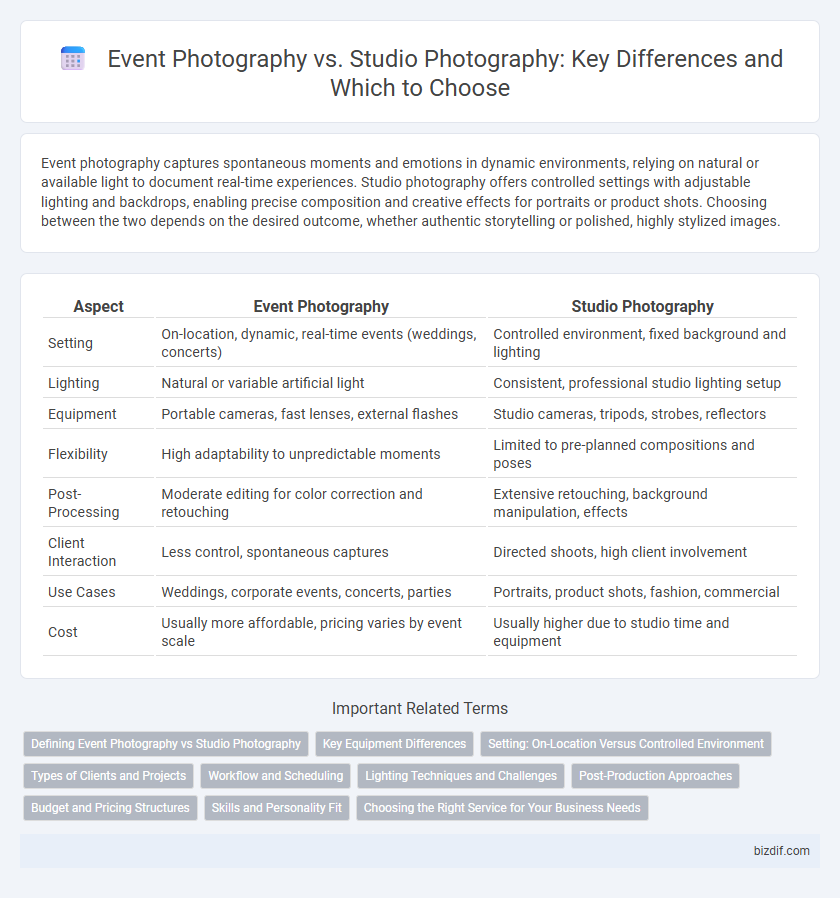Event photography captures spontaneous moments and emotions in dynamic environments, relying on natural or available light to document real-time experiences. Studio photography offers controlled settings with adjustable lighting and backdrops, enabling precise composition and creative effects for portraits or product shots. Choosing between the two depends on the desired outcome, whether authentic storytelling or polished, highly stylized images.
Table of Comparison
| Aspect | Event Photography | Studio Photography |
|---|---|---|
| Setting | On-location, dynamic, real-time events (weddings, concerts) | Controlled environment, fixed background and lighting |
| Lighting | Natural or variable artificial light | Consistent, professional studio lighting setup |
| Equipment | Portable cameras, fast lenses, external flashes | Studio cameras, tripods, strobes, reflectors |
| Flexibility | High adaptability to unpredictable moments | Limited to pre-planned compositions and poses |
| Post-Processing | Moderate editing for color correction and retouching | Extensive retouching, background manipulation, effects |
| Client Interaction | Less control, spontaneous captures | Directed shoots, high client involvement |
| Use Cases | Weddings, corporate events, concerts, parties | Portraits, product shots, fashion, commercial |
| Cost | Usually more affordable, pricing varies by event scale | Usually higher due to studio time and equipment |
Defining Event Photography vs Studio Photography
Event photography captures candid moments and authentic interactions in dynamic settings such as weddings, concerts, and corporate functions, emphasizing real-time storytelling. Studio photography involves controlled environments where lighting, backgrounds, and poses are meticulously managed to create polished portraits or product images. Both styles require distinct skills; event photographers excel in adaptability and fast decision-making while studio photographers focus on technical precision and artistic composition.
Key Equipment Differences
Event photography relies heavily on portable, versatile equipment such as fast lenses with wide apertures, external flashes with diffusers, and lightweight camera bodies to capture spontaneous moments in varying lighting conditions. Studio photography demands specialized gear including sturdy tripods, controlled light sources like softboxes and strobes, and tethered shooting setups to ensure precise lighting and composition. Both styles prioritize high-resolution cameras but differ significantly in lighting and mobility requirements to suit their distinct environments.
Setting: On-Location Versus Controlled Environment
Event photography captures candid moments in dynamic, on-location settings where natural lighting and spontaneous backgrounds create authentic atmospheres. Studio photography relies on a controlled environment with adjustable lighting, backdrops, and props to produce polished, consistent images tailored to specific artistic visions. The choice between event and studio photography hinges on the desired level of creative control versus capturing real-time, unscripted experiences.
Types of Clients and Projects
Event photography primarily serves clients such as corporations, wedding planners, and nonprofits seeking to capture live moments during conferences, weddings, or fundraisers. Studio photography attracts clients including fashion brands, models, and product companies aiming for controlled, high-quality images for advertising or editorial use. Each type requires different skills and equipment to meet the distinct demands of dynamic environments versus controlled settings.
Workflow and Scheduling
Event photography demands a flexible and fast-paced workflow, requiring photographers to adapt quickly to changing lighting and spontaneous moments. In contrast, studio photography follows a controlled, methodical workflow with scheduled sessions, allowing for precise lighting setups and meticulous composition. Scheduling for event photography is highly dynamic, often involving tight timelines and coordination with event organizers, whereas studio photography benefits from pre-planned appointments that optimize time management and creative preparation.
Lighting Techniques and Challenges
Event photography demands adaptive lighting techniques to manage unpredictable and often low-light environments, utilizing portable flashes, diffusers, and ambient light to capture candid moments effectively. Studio photography benefits from controlled lighting setups, employing softboxes, reflectors, and strobes to achieve precise illumination and consistent image quality. Challenges in event photography include rapidly changing light conditions and limited equipment mobility, while studio photography faces the complexity of achieving natural looks with artificial lighting and managing multiple light sources for desired effects.
Post-Production Approaches
Event photography post-production emphasizes rapid color correction and noise reduction to maintain the natural ambiance and spontaneous moments captured during live settings. Studio photography post-production allows for extensive retouching, background manipulation, and precise lighting adjustments, enhancing the controlled environment and artistic vision. Advanced editing software like Adobe Lightroom and Photoshop plays a critical role in both, tailoring workflow to suit either real-time event delivery or detailed studio enhancements.
Budget and Pricing Structures
Event photography pricing often includes variable costs such as hours of coverage, number of photographers, and post-production edits, making it adaptable to different budget ranges. Studio photography typically involves fixed pricing structures based on session length, number of final images, and use of studio equipment, resulting in more predictable expenses. Understanding these differences helps clients allocate budgets effectively according to the nature and requirements of their photography needs.
Skills and Personality Fit
Event photography demands quick adaptability, strong interpersonal communication, and the ability to anticipate spontaneous moments in dynamic environments. Studio photography requires meticulous technical skills, such as precise lighting control and creative composition, along with patience and attention to detail in a controlled setting. Photographers with outgoing, flexible personalities thrive in event settings, while those with a methodical, introverted nature tend to excel in studio work.
Choosing the Right Service for Your Business Needs
Event photography captures dynamic, candid moments in real-time settings, ideal for businesses seeking authentic representations of conferences, product launches, or corporate gatherings. Studio photography offers controlled environments with precise lighting and backgrounds, perfect for product showcases, headshots, or promotional material requiring consistent quality. Selecting the right service depends on your business's need for either spontaneous, interactive imagery or polished, meticulously crafted visuals.
Event Photography vs Studio Photography Infographic

 bizdif.com
bizdif.com